Flu Vaccination Coverage, United States, 2020–21 Influenza Season
FluVaxView webpage report posted online October 7, 2021
Summary
To reduce the risk of influenza (flu) illness, hospitalization and death, the Centers for Disease Control and Prevention (CDC) recommends routine annual flu vaccination for all people ≥6 months who do not have contraindications [1]. CDC analyzed data from two telephone surveys, the National Immunization Survey-Flu (NIS-Flu) and the Behavioral Risk Factor Surveillance System (BRFSS), to estimate flu vaccination coverage for the U.S. population during the 2020–21 flu season. Vaccination coverage with ≥1 dose of flu vaccine was 58.6% among children 6 months through 17 years, a decrease of 5.1 percentage points from the 2019–20 flu season, and flu vaccination coverage among adults ≥18 years was 50.2%, an increase of 1.8 percentage points from the prior season. Half (52.1%) of people ≥6 months were vaccinated during the 2020–21 season, similar to coverage in the prior season. Flu vaccination coverage has increased for adults over the past three flu seasons and had also been increasing for children until the 2020-21 season. Racial/ethnic disparities in flu vaccination coverage persist. Non-Hispanic Black (Black) children had lower flu vaccination coverage than children in all other racial/ethnic groups, and Hispanic children had lower coverage than non-Hispanic White (White) children and children of other or multiple (other) races. Hispanic adults and Black adults had lower flu vaccination coverage than White adults and adults of other races. Interpretation of the estimates in this report should take into account limitations of the surveys, including reliance on self- or parental report of vaccination status and low response rates, as well as level of consistency with findings from other surveys and data sources.
Getting a flu vaccine will be critical this fall and winter, because flu viruses and the virus that causes COVID-19 will likely be spreading simultaneously in the United States. Flu vaccination could help prevent or reduce the severity of flu illness; and a reduction of outpatient illnesses, hospitalizations, and intensive care unit admissions could alleviate stress on the U.S. health care system caused by COVID-19. September and October are good times to get vaccinated; however, as long as flu viruses are circulating, vaccination should continue. To avoid missed opportunities for vaccination, providers should offer vaccination during routine health care visits and hospitalizations. Guidance for vaccine planning during the COVID-19 pandemic is available.
Methods
For this report, CDC analyzed data from the NIS-Flu for children 6 months through 17 years and the BRFSS for adults ≥18 years to estimate national- and state-level flu vaccination coverage for the 2020–21 flu season. The analyses included data collected from interviews completed during September (BRFSS) or October (NIS-Flu) 2020 through June 2021 and report on vaccinations received between July 1, 2020 and the time of interview or by May 31, 2021 for those interviewed in June.
The NIS-Flu is a national random-digit-dialed cellular telephone survey of households [2]. Respondents ≥18 years knowledgeable about the child’s vaccinations (hereafter referred to as “parent” in this report) were asked if their child had received a flu vaccination since July 1, 2020, and, if so, in which month; this information was not verified by medical records. For the 15.1% of respondents who indicated their child had been vaccinated but had a missing month of vaccination, month was imputed from other survey respondents with non-missing month of vaccination, matched for week of interview, age group, state of residence, and race/ethnicity using the hot-deck imputation method. Respondents who indicated the child received a flu vaccination were also asked the kind of place at which the child was vaccinated. The range of the Council of American Survey and Research Organizations (CASRO) response rates for the NIS-Flu for the 2020–21 season was 21.8%–23.9%. The estimates for children are based on n=145,783 completed NIS-Flu interviews.
The BRFSS is a state-based random-digit-dialed cellular and landline telephone survey which collects information on a variety of health conditions and risk behaviors from one randomly selected adult ≥18 years in a household. The BRFSS includes survey questions asking whether the respondent had received a flu vaccination in the past 12 months, and if so, in which month and year. Responses to the flu vaccination status questions were not verified by medical records. Respondents who did not have either a yes or no response to the question on whether they received flu vaccination in the past 12 months were excluded from the analysis; this included 0.4% who reported they did not know, 0.1% who refused to answer the question, and 5.6% who most likely ended the interview before the flu question was asked. For 7.5% of BRFSS participants who indicated they had been vaccinated but had a missing month and year of vaccination, the month of vaccination was imputed from other survey respondents with non-missing month of vaccination matched for week of interview, age group, state of residence, and race/ethnicity using the hot-deck imputation method. Information on high-risk conditions was missing for 1.2% of adults; these respondents were not included in the estimates by risk condition. Estimates are not available for the entire 2020–21 flu season from Florida; interview data for January–June 2021 from Florida were not available at the time of this report. Respondents who indicated they received a flu vaccination were also asked the kind of place at which they were vaccinated. The median state BRFSS response rate for a complete or partially complete interview was 46.0% for September–December 2020 and 45.7% for January–June 2021. The estimates for adults are based on n=291,711 completed BRFSS interviews.
Flu vaccination coverage estimates from both surveys were calculated using Kaplan-Meier survival analysis using month of reported flu vaccination to determine cumulative flu vaccination coverage. Coverage estimates for all persons ≥6 months were determined using combined state-level monthly estimates weighted by the age-specific populations of each state [3]. All estimates were weighted and analyzed using SAS and SAS-callable SUDAAN statistical software to account for the complex survey designs. For simplified graphical display, only four racial/ethnic groups are displayed (Hispanic, White, Black, and other races); a more detailed racial/ethnic breakdown of estimates is included as a table weblink in the report. Differences between groups and between 2020–21 and prior season (2019–20) estimates were determined using t-tests with significance at p<0.05. Increases or decreases noted in this report were statistically significant differences.
Results
Children (6 months through 17 years) – By Age Group
Among children 6 months through 17 years, the percentage receiving ≥1 dose of flu vaccine during the 2020–21 season was 58.6%, which was 5.1 percentage points lower than coverage in the 2019–20 season (63.7%; Figure 1). Flu vaccination coverage decreased 7.2 percentage points among children 6 months–4 years, 5.5 percentage points among children 5–12 years, and 2.5 percentage points among children 13–17 years compared with the 2019–20 season (Figure 1). As observed in previous flu seasons, flu vaccination coverage was lower for older children compared with younger children.
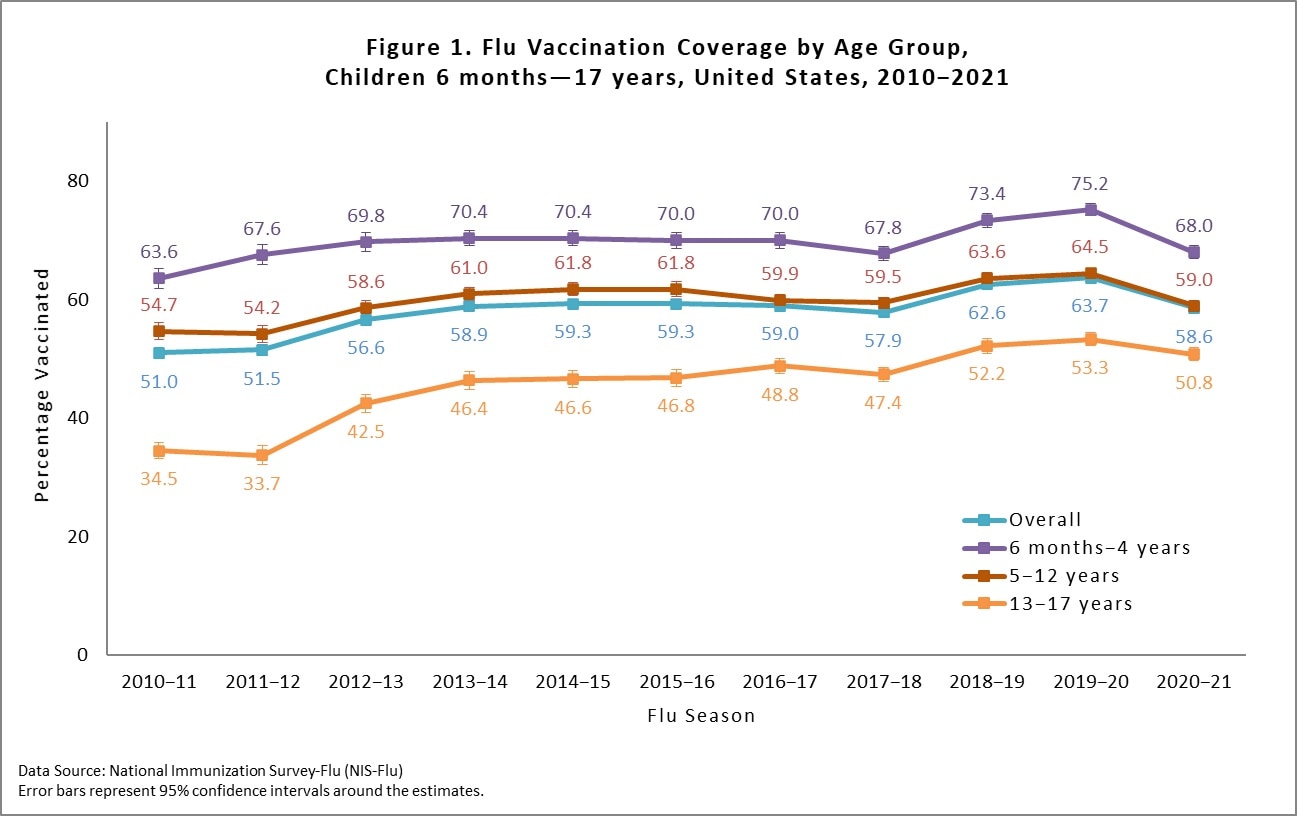
Children (6 months through 17 years) – By State
There was large between-state variability in flu vaccination coverage among children, ranging from 42.9% (Mississippi) to 83.6% (Massachusetts; Figure 2). See the interactive FluVaxView application for additional state-level estimates by age-groups and multiple flu seasons.
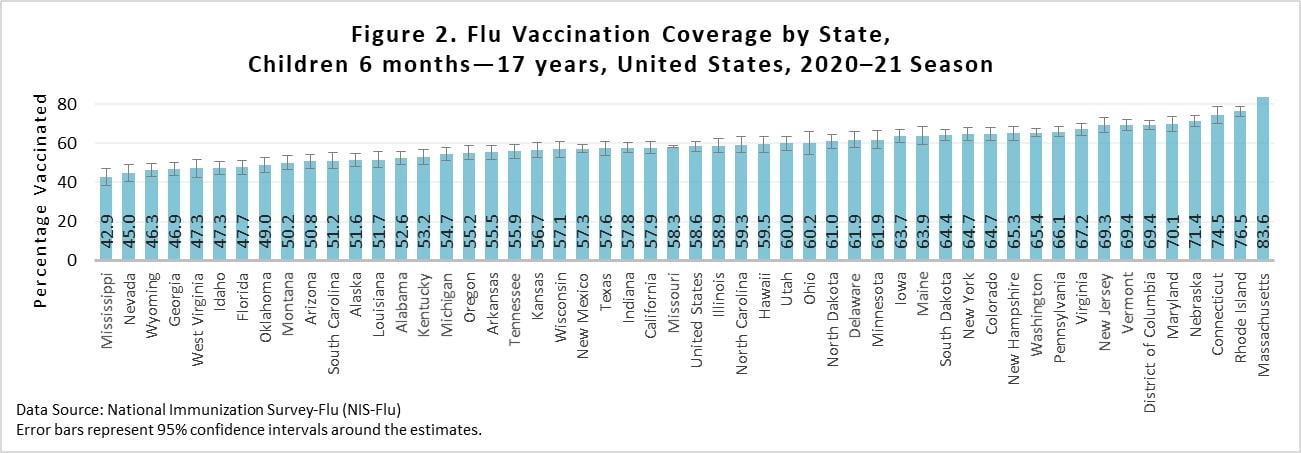
Children (6 months through 17 years) – By Racial/Ethnic Group
Flu vaccination coverage for White, Black, Hispanic, and children of other races during the 2020–21 season was lower compared with the 2019–20 season (Figure 3). Significant differences in flu vaccination coverage were observed between racial/ethnic groups. Black children had lower flu vaccination coverage than children in all other racial/ethnic groups. Children of other races had higher flu vaccination coverage than Black, White, and Hispanic children. Hispanic children had lower coverage than White children and children of other races. No other statistically significant pair-wise differences were observed. Flu vaccination coverage estimates for more detailed racial/ethnic groups (Asian, American Indian/Alaska Native, other or multiple races) is provided as a table weblink in the “Additional Flu Vaccination Coverage Estimates” section of this report.
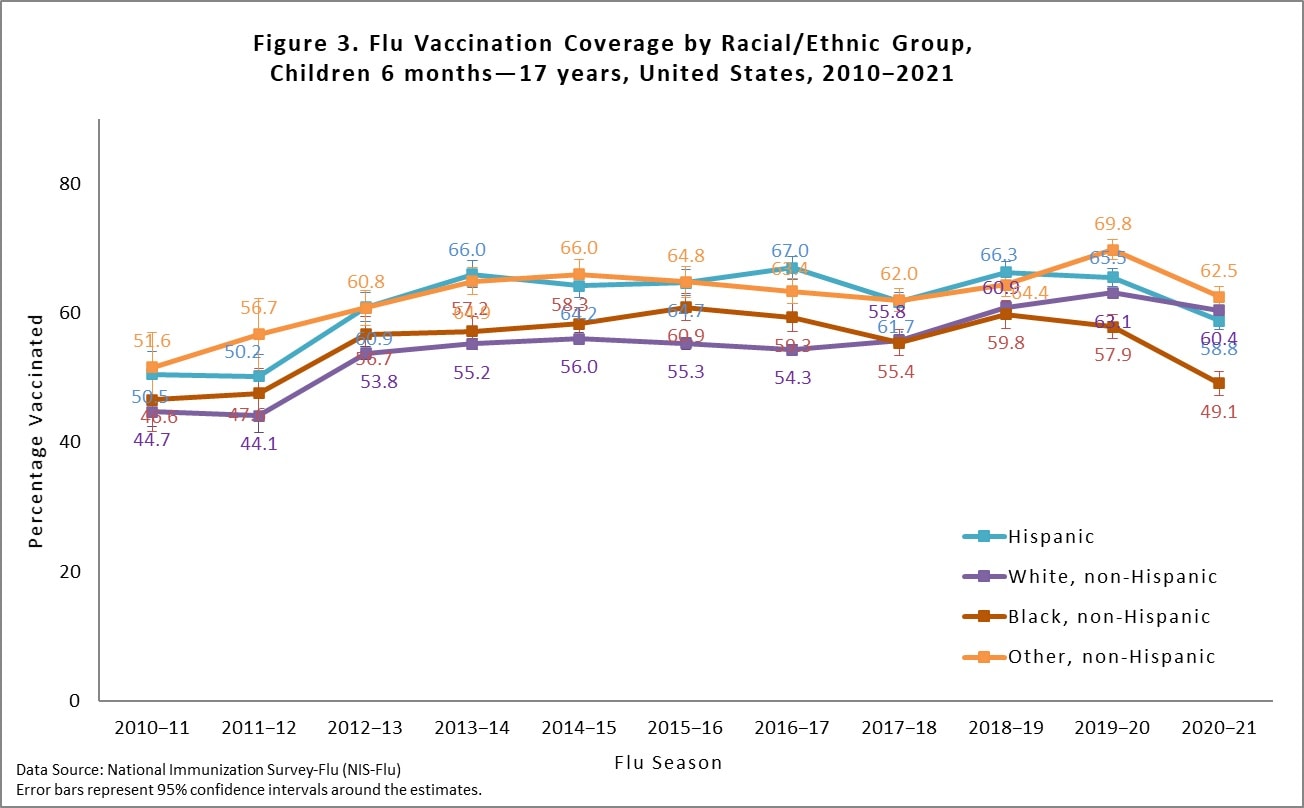
Adults (≥18 years) – By Age Group
Overall, among adults ≥18 years, flu vaccination coverage was 50.2%, 1.8 percentage points higher than coverage during the 2019–20 season (48.4%; Figure 4). Flu vaccination coverage for 2020–21 was 3.6 percentage points higher for adults 50–64 years and 5.4 percentage points higher for adults ≥65 years, but coverage did not significantly increase among adults 18–49 years compared with the 2019–20 season (Figure 4). As observed in previous seasons, flu vaccination coverage was higher for older adults compared with younger adults.
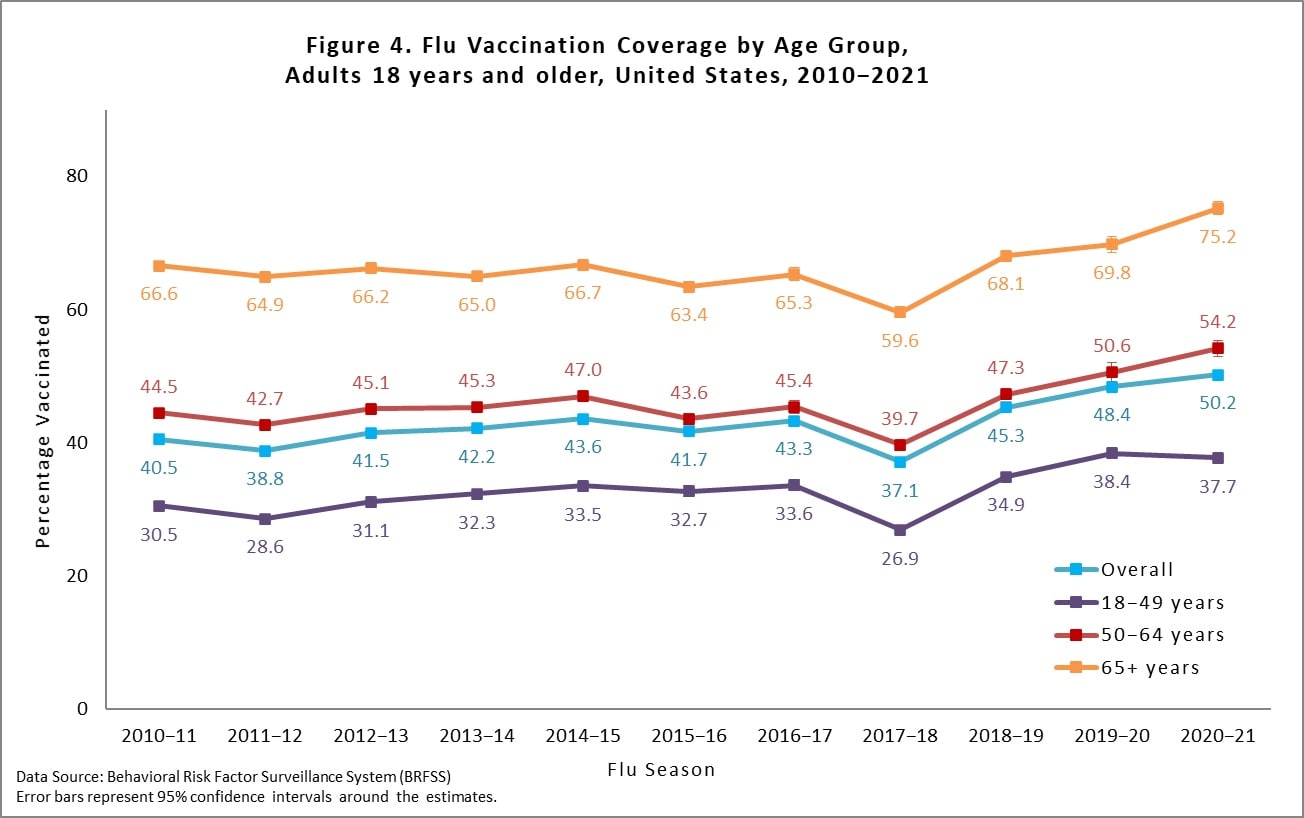
There was large between-state variability in flu vaccination coverage among adults, ranging from 41.5% in Wyoming to 64.0% in Rhode Island (Figure 5). See the interactive FluVaxView application for additional state-level estimates by age-groups and multiple flu seasons.
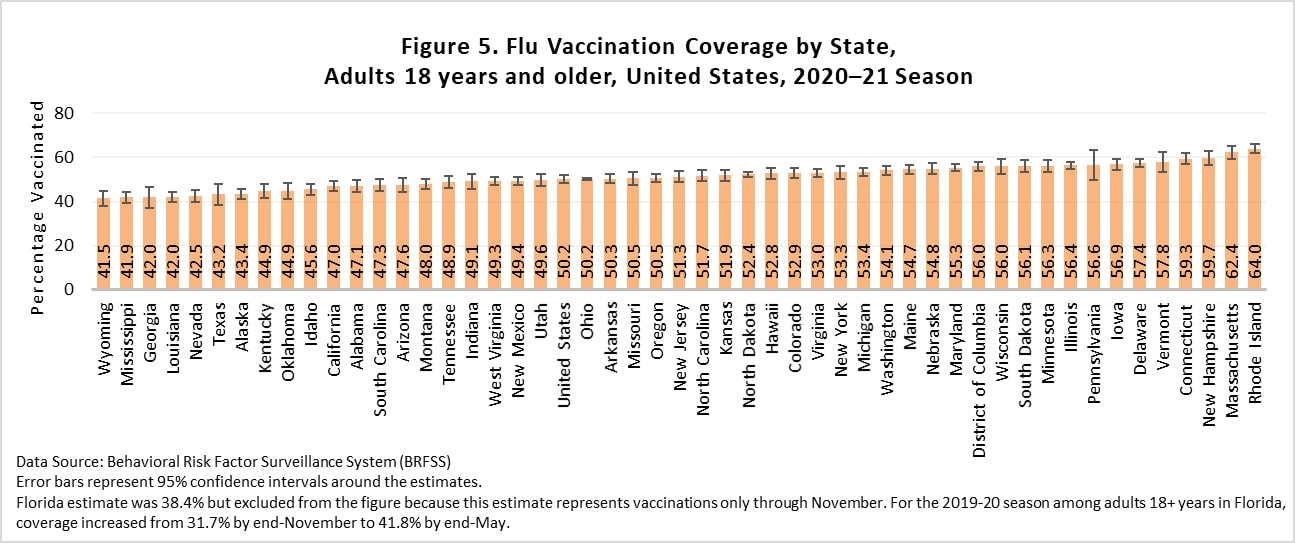
Adults (≥18 years) – By Racial/Ethnic Group
Flu vaccination coverage for Black, Hispanic, and adults of other races during the 2020–21 season did not show statistically significant changes compared with the 2019–20 season, while White adults had an increase in coverage (Figure 6). Similar to the 2019–20 season, differences in flu vaccination coverage were observed between racial/ethnic groups. White adults had higher coverage than Black, Hispanic, and adults of other racial/ethnic groups. Additionally, Hispanic and Black adults had lower flu vaccination coverage than adults of other racial/ethnic groups. No other statistically significant pair-wise differences were observed. Flu vaccination coverage estimates for more detailed racial/ethnic groups (Asian, American Indian/Alaska Native, other or multiple races) are provided as a table weblink in the “Additional Flu Vaccination Coverage Estimates” section of this report.
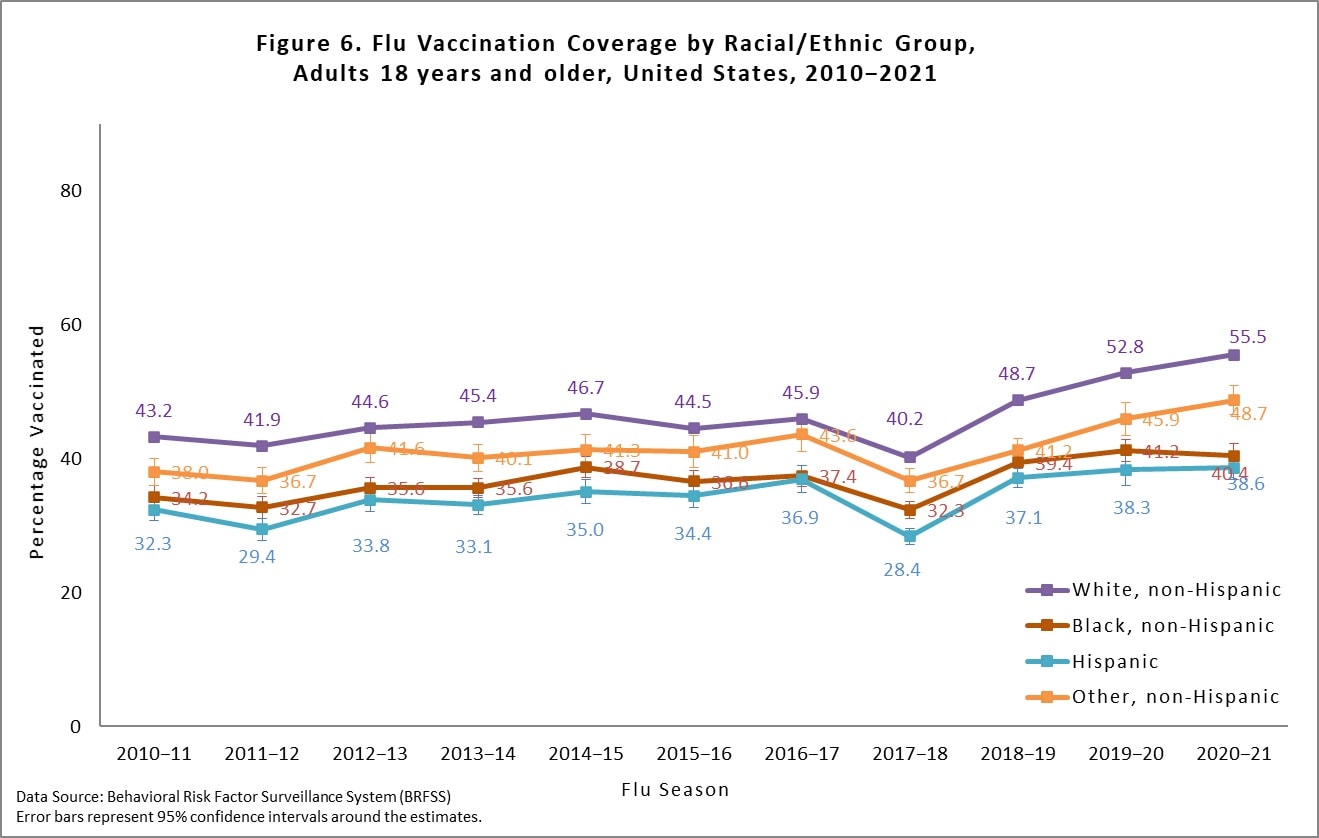
All people 6 months and older
Among all people ≥6 months, the percentage vaccinated during the 2020–21 season was 52.1%, similar to coverage in the 2019–20 season (51.8%; Table 1). Coverage during the 2020–21 season increased for White people but decreased for Black people (Table 1). White people had higher flu coverage than Black, Hispanic, and people of other races. Additionally, people of other races had higher coverage than Black and Hispanic people. Lastly, Hispanic people had higher coverage than Black people. No other statistically significant pair-wise differences were observed.
* Estimates of the percentage vaccinated are based on interviews conducted September (BRFSS) or October (NIS-Flu) 2020 through June 2021 and reported vaccinations from July 2020 through May 2021.
† Excludes U.S. territories.
‡ Race is self-reported; people of Hispanic ethnicity may be of any race.
§ Percentage vaccinated. Percentages are weighted to the U.S. population. Month of vaccination was imputed for respondents with missing month of vaccination data.
|| Confidence interval (CI) half-widths.
¶ Statistically significant difference between the 2020–21 season and the 2019–20 season by t-test (p<0.05).
** Includes Asian, American Indian/Alaska Native, Native Hawaiian or other Pacific Islander, multiracial, and other races.
Place of Vaccination – Children
Place of flu vaccination among vaccinated children 6 months through 17 years was most often a doctor’s office (68%), followed by clinic/health center (12%), and pharmacy (12%; Figure 7). A weblink to place of flu vaccination by child age groups is included in the additional tables in the next section of this report.
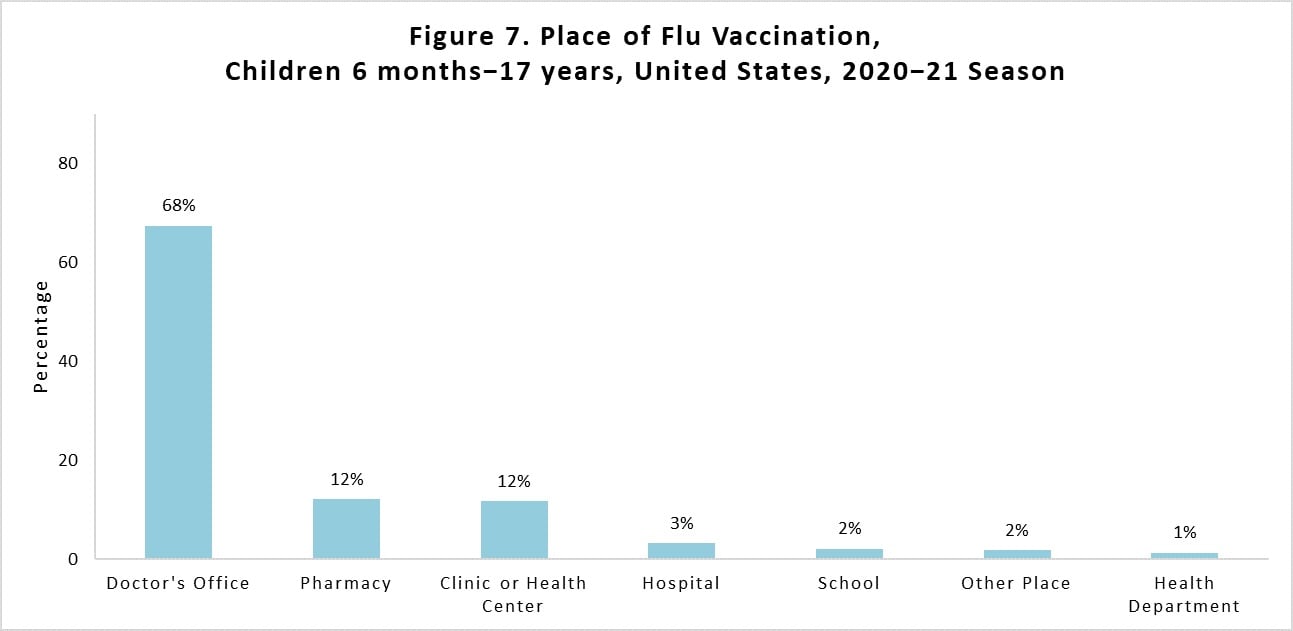
Place of flu vaccination among vaccinated adults ≥18 years was most often at a pharmacy or store (39%), followed by a doctor’s office or health maintenance organization (HMO) (34%; Figure 8). A weblink to place of flu vaccination by adult age groups is included in the additional tables in the next section of this report.
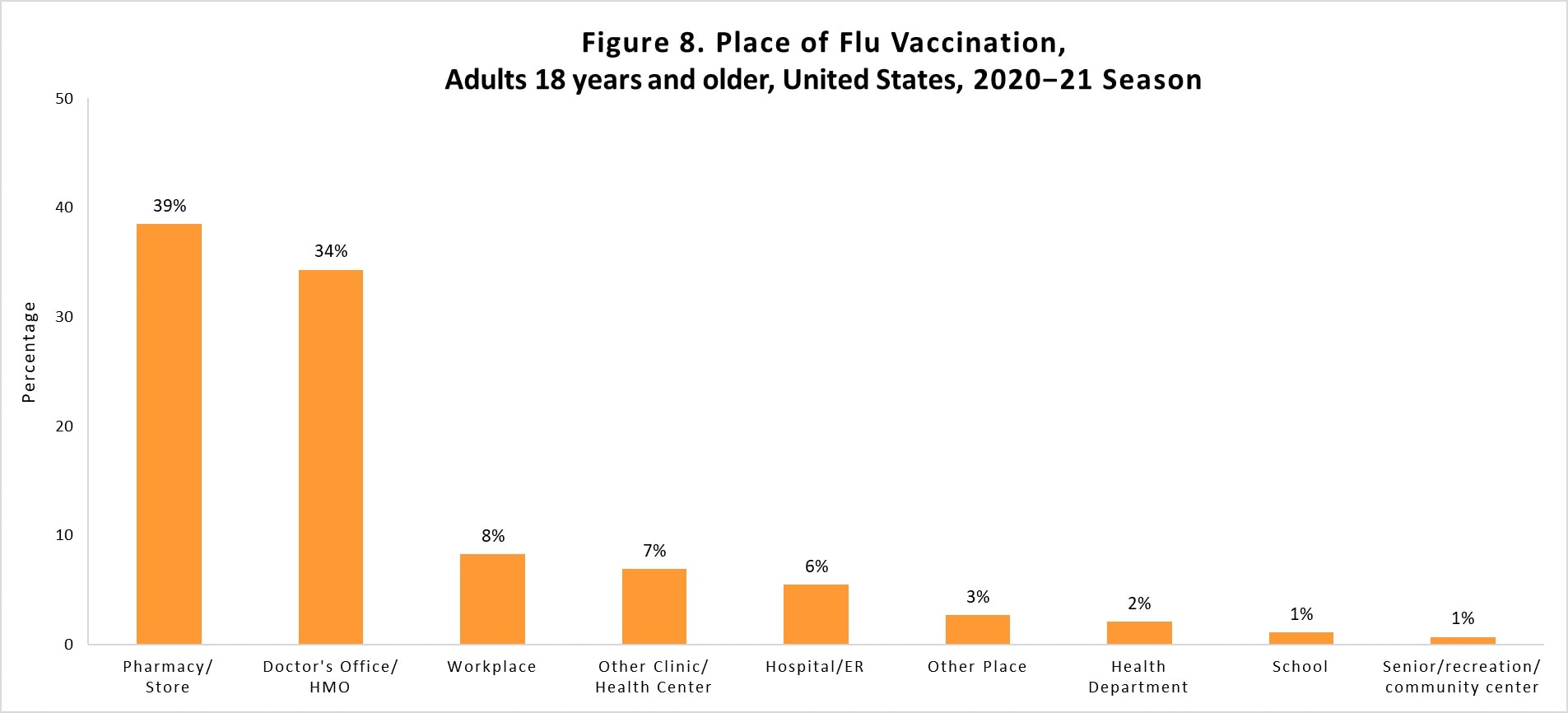
- Flu Vaccination Coverage, by Age Group, Children, United States, 2020–21 Season
- Flu Vaccination Coverage by Sex, Children, United States, 2020–21 Season
- Flu Vaccination Coverage by Race/Ethnicity and Age Group, Children, United States, 2020–21 Season
- Flu Vaccination Coverage for Local Areas and Territories, Children, 2020–21 Season
- Place of Flu Vaccination by Age Group, Children, United States, 2020–21 Season
Adults:
- Flu Vaccination Coverage, by Age Group and High Risk Status, Adults, United States, 2020–21 Season
- Flu Vaccination Coverage by Sex, Adults, United States, 2020–21 Season
- Flu Vaccination Coverage by Race/Ethnicity and Age Group, Adults, United States, 2020–21 Season
- Flu Vaccination Coverage for Local Areas and Territories, Adults, 2020–21 Season
- Place of Flu Vaccination by Age Group, Adults, United States, 2020–21 Season
Limitations
Interpretation of the results in this report should take into account several limitations of the estimates produced from the NIS-Flu and BRFSS surveys. First, survey weighting adjustments may not eliminate all the possible bias from incomplete sample frames; both surveys exclude households with no telephones, and NIS-Flu also excludes households with only landline telephones. Second, response rates for both surveys were low, and flu vaccination coverage may differ between survey respondents and non-respondents; survey weighting adjustments may not adequately control for these differences. Third, there may be errors in flu vaccination status due to recall error of parents for NIS-Flu and of respondents for BRFSS [4, 5]. Fourth, errors from incomplete sample frame, nonresponse, and accuracy of reported flu vaccination status might change over time, which could lead to inaccurate assessment of trends in flu vaccination coverage. Fifth, due to BRFSS interview data not being available for all months from Florida, estimates for Florida represent vaccination coverage through November rather than through May. Sixth, estimates based on the sources in this report have differed from National Health Interview Survey (NHIS) estimates, the data source for evaluating progress toward the Healthy People 2020 and 2030 flu vaccination coverage objectives; NHIS uses a different sampling method and in-person interviews but does also rely on self or parental report [6-9]. A recent study found that NIS-Flu estimates were generally higher than NHIS estimates over several flu seasons for children [10]. CDC continues to assess consistency between flu vaccination coverage estimates from different surveys and other data sources and evaluate accuracy of estimates from these data sources. Although 52% were vaccinated according to the results in this report, this estimate may not be the actual proportion vaccinated given the limitations stated above.
CDC launched a Weekly National Flu Vaccination Dashboard in December 2020 to share preliminary, within-season, influenza vaccination data and coverage estimates for 2020–21 and prior seasons using existing (e.g., NIS-Flu) and new data sources (e.g., Vaccine Safety Datalink for pregnant persons). CDC plans updates to this weekly dashboard during the 2021–22 flu season to include jurisdiction-level coverage for children from the NIS-Flu. To provide within-season weekly estimates of flu vaccination for adults, CDC acquired projected estimates, based on claims data, of the number of flu vaccines given at pharmacies and medical offices in the United States from IQVIA. Based on these IQVIA data, as of April 10, 2021, an estimated 47.7 million adult flu vaccinations had been administered in pharmacies compared with 35.4 million at the same time in 2020 (35% higher in 2021) and 32.8 million adult flu vaccinations were reported to have been administered in physician medical offices compared with 36.9 million at the same time in 2020 (11% lower in 2021). CDC continues to evaluate these new and existing data sources, including exploring methods to calculate IQVIA-derived flu coverage estimates, how these preliminary during-season estimates differ from end-of-season estimates, and impact of data from these sources, including how stakeholders were able to utilize data.
Discussion
Flu vaccination coverage during the 2020–21 season was lower than coverage during the 2019–20 season for children but higher for adults. Prior to the 2020–21 season, increases in coverage had been observed for children for two consecutive seasons [11, 12]. The decrease in coverage among children in the 2020–21 season is likely due to public health response measures to mitigate the COVID-19 pandemic, such as social distancing and quarantine policies, resulting in decreased usage of routine immunization services; a decrease in coverage for routine childhood vaccination has also been documented in several previously published studies [13-16]. For adults, flu vaccination coverage has increased for the last three consecutive seasons [11, 12] yet is still nearly 20 percentage points lower than the Healthy People 2030 national target of 70% for flu vaccination of persons ≥6 months; coverage among children is lagging by more than 10 percentage points [8]. Furthermore, flu vaccination coverage in some states and among some racial/ethnic groups continues to be far from optimal.
CDC recommends that all people 6 months and older get a yearly flu vaccine, with rare exceptions. Getting an annual flu vaccine this fall is very important to protect yourself, your loved ones, and your community against flu, and is more important than ever during the 2021–22 flu season because flu and SARS-CoV-2 (the virus that causes COVID-19) will likely be spreading in the United States at the same time. Flu vaccines will not protect against COVID-19 but have been shown to reduce the risk of flu illness, hospitalization, and death, and, thus, can help reduce the burden on the health care system and conserve potentially scarce health care resources during the on-going COVID-19 pandemic. Vaccinating people at higher risk, including those with a chronic condition like a breathing or lung problem, heart disease, or a weakened immune system, is a critical strategy to help decrease their risk of severe flu illness. Many people at higher risk from flu complications also are at higher risk from COVID-19.
Health care providers should use every opportunity during the flu season to administer flu vaccines to all eligible persons; COVID-19 vaccines may be administered without regard to timing of other vaccines [17]. September and October are good times to get vaccinated; however, as long as flu viruses are circulating vaccination should continue. For the 2021–22 season, vaccine manufacturers have projected they will provide as many as 188–200 million doses of flu vaccine [18].
References
- Grohskopf, L.A., et al., Prevention and Control of Seasonal Influenza with Vaccines: Recommendations of the Advisory Committee on Immunization Practices, United States, 2021-22 Influenza Season. MMWR Recomm Rep, 2021. 70(5): p. 1-28.
- Wolter, K.K., et al., Statistical Methodology of the National Immunization Survey, 2005-2014. Vital Health Stat 1, 2017(61): p. 1-107.
- Furlow-Parmley, C., et al., Combining estimates from two surveys: an example from monitoring 2009 influenza A (H1N1) pandemic vaccination. Stat Med, 2012. 31(27): p. 3285-94.
- Brown, C., et al., Validity of parental report of influenza vaccination in young children seeking medical care. Vaccine, 2011. 29(51): p. 9488-92.
- Irving, S.A., et al., Evaluation of self-reported and registry-based influenza vaccination status in a Wisconsin cohort. Vaccine, 2009. 27(47): p. 6546-9.
- Black, L.I., A.E. Ng, and B. Zablotsky, Influenza Vaccination in the Past 12 Months Among Children Aged 6 Months-17 Years: United States, 2019. NCHS Data Brief, 2021(407): p. 1-8.
- CDC. FluVaxView, Influenza vaccination coverage. [cited 09/03/2021]; Available from: https://www.cdc.gov/flu/fluvaxview/index.htm.
- Office of Disease Prevention and Health Promotion. Healthy People 2030: Increase the proportion of people who get the flu vaccine every year — IID‑09. [cited 09/03/2021]; Available from: https://health.gov/healthypeople/objectives-and-data/browse-objectives/vaccination/increase-proportion-people-who-get-flu-vaccine-every-year-iid-09.
- National Center for Health Statistics. Percentage of receipt of influenza vaccination in the past 12 months for adults aged 18 and over, United States , 2019 Q1, Jan-Mar—2021 Q1, Jan-Mar. National Health Interview Survey. Generated interactively. [cited 09/03/2021]; Available from: https://wwwn.cdc.gov/NHISDataQueryTool/ER_Quarterly/index_quarterly.html.
- Santibanez, T.A., et al., Trends in Childhood Influenza Vaccination Coverage, United States, 2012-2019. Public Health Rep, 2020. 135(5): p. 640-649.
- CDC. Flu Vaccination Coverage, United States, 2018–19 Influenza Season. 2019 [cited 09/03/2021]; Available from: https://www.cdc.gov/flu/fluvaxview/coverage-1819estimates.htm.
- CDC. Flu Vaccination Coverage, United States, 2019–20 Influenza Season. 2020 [cited 09/03/2021]; Available from: https://www.cdc.gov/flu/fluvaxview/coverage-1920estimates.htm.
- Ackerson, B.K., et al., Pediatric Vaccination During the COVID-19 Pandemic. Pediatrics, 2021. 148(1): p. e2020047092.
- Bramer, C.A., et al., Decline in Child Vaccination Coverage During the COVID-19 Pandemic – Michigan Care Improvement Registry, May 2016-May 2020. MMWR Morb Mortal Wkly Rep, 2020. 69(20): p. 630-631.
- O’Leary, S.T., et al., Number of Childhood and Adolescent Vaccinations Administered Before and After the COVID-19 Outbreak in Colorado. JAMA Pediatr, 2021. 175(3): p. 305-307.
- Santoli, J.M., et al., Effects of the COVID-19 Pandemic on Routine Pediatric Vaccine Ordering and Administration – United States, 2020. MMWR Morb Mortal Wkly Rep, 2020. 69(19): p. 591-593.
- CDC. Interim Clinical Considerations for Use of COVID-19 Vaccines Currently Approved or Authorized in the United States. [cited 09/07/2021]; Available from: https://www.cdc.gov/vaccines/covid-19/clinical-considerations/covid-19-vaccines-us.html#Coadministration.
- CDC. Seasonal Influenza Vaccine Supply for the U.S. 2021-2022 Influenza Season. [cited 09/03/2021]; Available from: https://www.cdc.gov/flu/prevent/vaxsupply.htm.